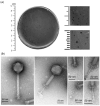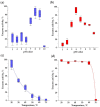Bacteriolytic Potential of Enterococcus Phage iF6 Isolated from "Sextaphag®" Therapeutic Phage Cocktail and Properties of Its Endolysins, Gp82 and Gp84
- PMID: 36992476
- PMCID: PMC10054541
- DOI: 10.3390/v15030767
Bacteriolytic Potential of Enterococcus Phage iF6 Isolated from "Sextaphag®" Therapeutic Phage Cocktail and Properties of Its Endolysins, Gp82 and Gp84
Abstract
The number of infections caused by antibiotic-resistant strains of bacteria is growing by the year. The pathogenic bacterial species Enterococcus faecalis and Enterococcus faecium are among the high priority candidate targets for the development of new therapeutic antibacterial agents. One of the most promising antibacterial agents are bacteriophages. According to the WHO, two phage-based therapeutic cocktails and two medical drugs based on phage endolysins are currently undergoing clinical trials. In this paper, we describe the virulent bacteriophage iF6 and the properties of two of its endolysins. The chromosome of the iF6 phage is 156,592 bp long and contains two direct terminal repeats, each 2108 bp long. Phylogenetically, iF6 belongs to the Schiekvirus genus, whose representatives are described as phages with a high therapeutic potential. The phage demonstrated a high adsorption rate; about 90% of iF6 virions attached to the host cells within one minute after the phage was added. Two iF6 endolysins were able to lyse enterococci cultures in both logarithmic and stationary growth phases. Especially promising is the HU-Gp84 endolysin; it was active against 77% of enterococci strains tested and remained active even after 1 h incubation at 60 °C. Thus, iF6-like enterococci phages appear to be a promising platform for the selection and development of new candidates for phage therapy.
Keywords: Enterococcus faecalis; Enterococcus faecium; Kochikohdavirus; Shiekvirus; antibiotic resistance; bacteriophage; endolysins; iF6; phage therapy.
Conflict of interest statement
The authors declare no conflict of interest.
Figures










References
-
- Geneva: World Health Organization 2020 Antibacterial Agents in Clinical and Preclinical Development: An Overview and Analysis. World Health Organization; Geneva, Switzerland: 2021.
-
- Sood S., Malhotra M., Das B.K., Kapil A. Enterococcal Infections & Antimicrobial Resistance. Indian J. Med. Res. 2008;128:111–121. - PubMed
Publication types
MeSH terms
Substances
LinkOut - more resources
Full Text Sources

